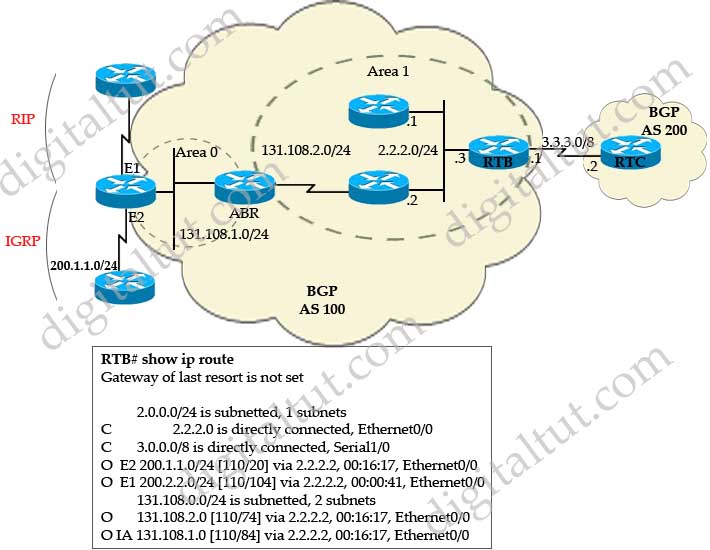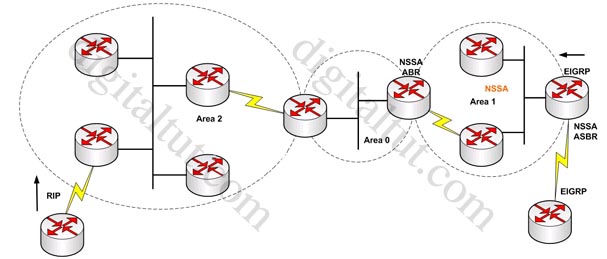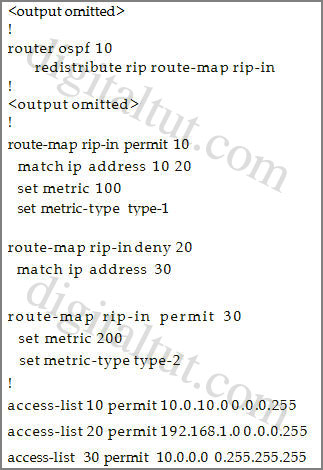Redistribute Questions 4
Here you will find answers to Redistribute Questions – Part 4
Question 1
You have implemented mutual route redistribution between OSPF and EIGRP on a border router. When checking the routing table on one of the OSPF routers within the OSPF routing domain, you are seeing some, but not all of the expected routes.
Which two things should you verify to troubleshoot this problem? (Choose two)
A. The border router is using a proper seed metric for OSPF.
B. The border router is using a proper seed metric for EIGRP.
C. The administrative distance is set for OSPF and EIGRP.
D. The missing EIGRP routes are present in the routing table of the border router.
E. The subnet keyword on the border router in the redistribute EIGRP command.
Answer: D E
Explanation
Answer D is obvious that we should check all the routes we want to redistribute are present in the routing table of the border router. Let’s discuss about answer E.
A rule of thumb when redistributing into OSPF is we should always include the “subnets” keyword after the redistributed route. For example:
| router ospf 1 redistribute eigrp 100 subnets |
This keyword makes sure all of the routes, including subnets are redistributed correctly into OSPF. For example these routes are learned via EIGRP:
+ 192.168.1.0/24
+ 192.168.2.0/25
+ 192.168.3.0/26
Then without the keyword “subnets”, only 192.168.1.0/24 network is redistributed into OSPF.
For more information about “subnets” keyword, please read my Redistribute EIGRP and OSPF in GNS3 guide.
Question 2
Which three steps are most helpful in verifying proper route redistribution? (Choose three)
A. On the routers not performing the route redistribution, use the show ip route command to see if the redistributed routes show up.
B. On the ASBR router performing the route redistribution, use the show ip protocol command to verify the redistribution configurations.
C. On the ASBR router performing the route redistribution, use the show ip route command to verify that the proper routes from each routing protocol are there.
D. On the routers not performing the route redistribution, use the show ip protocols command to verify the routing information sources.
E. On the routers not performing the route redistribution, use the debug ip routing command to verify the routing updates from the ASBR.
Answer: A B C
Question 3
A router is configured for redistribution to advertise EIGRP routes into OSPF on a boundary router. Given the configuration:
router ospf 1
redistribute eigrp 1 metric 25 subnets
What is the function of the 25 parameter in the redistribute command?
A. It specifies the seed cost to be applied to the redistributed routes.
B. it specifies the administrative distance on the redistributed routes.
C. It specifies the metric limit of 25 subnets in each OSPF route advertisement.
D. It specifies a new process-id to inject the EIGRP routes into OSPF.
Answer: A
Question 4
Which command should be added to RTB under router bgp 100 to allow only the external OSPF routes to be redistributed to RTC?

A. redistribute ospf 1
B. redistribute ospf 1 match external 1
C. redistribute ospf 1 match external 2
D. redistribute ospf 1 match external 1 external 2
Answer: D
Question 5
Refer to the exhibit. Will redistributed RIP routes from OSPF Area 2 be allowed in Area 1?

A – Because Area 1 is an NSSA, redistributed RIP routes will not be allowed.
B – Redistributed RIP routes will be allowed in Area 1 because they will be changed into type 5 LSAs in Area 0 and passed on into Area 1
C – Because NSSA will discard type 7 LSAs, redistributed RIP routes will not be allowed in Area 1
D – Redistributed RIP routes will be allowed in Area 1 because they will be changed into type 7 LSAs in Area 0 and passed on into Area 1
Answer: A
Explanation
Because Area 1 is a Not-so-stubby-area (NSSA), we can inject EIGRP routes into the OSPF NSSA domain with the creation of type 7 LSAs. Redistributed RIP routes are not allowed in Area 1 because NSSA is an extension to the stub area (recall that a stub area does not accept external route unless it is connected through a ASBR, doing that will make it become a NSSA). The type 7 LSAs are converted to Type 5 LSAs when flooded into Area 0 by the ABR router.
Question 6
Look at the following exhibit. Which of the following correctly states the routes to be redistributed into OSPF? (Choose two)

A – The network 10.0.10.0/24 will be allowed and assigned a metric of 200
B – All networks except 10.0.0.0/8 will be allowed and assigned a metric of 200
C – The network 172.16.0.0/16 will be allowed and assigned a metric of 200
D – The network 192.168.1.0 will be allowed and assigned a metric of 100
Answer: C D
Explanation
Let’s analyze each route-map clause. The first one is:
| route-map rip-in permit 10 match ip address 10 20 set metric 100 set metric-type type-1 |
If a match command refers to several objects in one command, either of them should match (the logical OR algorithm is applied). For example, in the match ip address 10 20 command, a route is permitted if it is permitted by access list 10 or access list 20 -> The networks 10.0.10.0/24 and 192.168.1.0/24 will be matched and be set metric of 100 and metric-type of Type-1. -> D is correct.
If the traffic is not matched by the first clause, the second clause is used to check:
| route-map rip-in deny 20 match ip address 30 |
In this clause, the keyword “deny” will cause the network matched by access-list 30 to be dropped -> Network 10.0.0.0/8 will be dropped.
The last clause is:
| route-map rip-in permit 30 set metric 200 set metric-type type-2 |
In this clause no match statement is found so all remaining routes (networks) are matched here. They will be set a metric of 200 and metric-type of Type-2. -> “network 172.16.0.0/16 will be allowed and assigned a metric of 200” -> C is correct.
(Good resource about route-map: http://www.cisco.com/c/en/us/support/docs/ip/border-gateway-protocol-bgp/49111-route-map-bestp.html)


